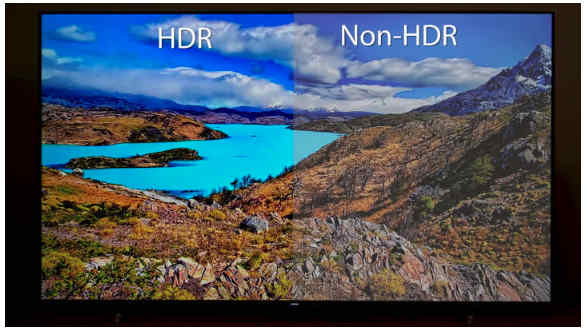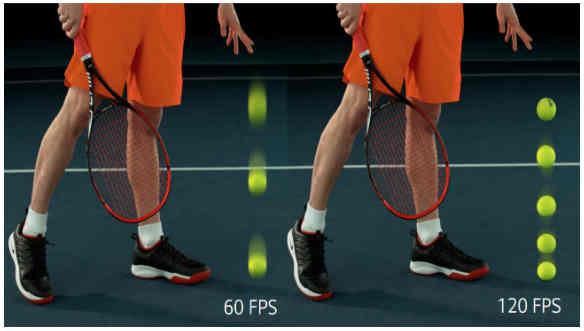Table of Contents
TV appeared from the end of 1920. With the increasingly developing technology trend, up to now, TV has been an advanced device, perfecting new designs as well as new technologies. In the future, there will be many new technologies appearing on television.
TV High Dynamic Range
A few years back, the High Dynamic Range (HDR) feature was integrated on most recording devices from professional to amateur. In essence, this feature makes a big difference in the color and lighting spaces that are not possible with normal images. Specifically, HDR makes the color space and light become wider, making the image more vivid and flattering than reality.

HDR results are achieved through digital image processing interference. However, this is only effective when recording images, because at that time the received image signal has not been processed, the image data is still abundant. After the image is processed, it will be difficult to expand the color and lighting space (according to the HDR technique) without losing image quality. That is why HDR is currently only available on recording devices and broadcast devices like TVs are not.
This is the right time for video recording equipment manufacturers to create new image formats, which contain more data information. For then, the TV will have the facilities and resources to process the image at will before playing. And most likely will be the HDR processing technique.
Amazon Prime also recently introduced the first video content to support the HDR standard. Netflix, the world's second-largest internet television service provider, also said it will soon release content formats with larger image data this year.
Traditional TVs without HDR only allow you to see details in an area, either inside a dark room or outside in a bright environment. Meanwhile, a TV with HDR processing can process images that show both dark and bright areas clearly at the same time. If the input is good enough, the results you see will reach the point where the human eye cannot actually see the same thing.
Because of its effectiveness, this feature will soon be popularized on TV screens in the near future. After Amazon Prime, Netflix, there are likely to be more content makers following this trend.
TV High Framerate
Along with the resolution, we still often see parameters such as 60fps, 25fps, 24fps, etc These are the parameters index framerate - frame rate scan.

The higher the number of fps, the larger the frame rate, the smoother and smoother the image will be. With that, the hardware of the media player requires more power. In the issue of video resolution, we have made rapid strides as 4K, 8K movies appear continuously. But few people know, they usually only have low framerate below 25 frames / sec. So sometimes the feeling of watching them is not even as good as the Full-HD 120fps, 60fps movies. This is especially true for videos with lots of fast movements such as sports or wildlife.
So, after the resolution, high framerate is what video recording equipment manufacturers are aiming for. As 4K and 8K videos with high framerate appear more, of course TV screen manufacturers will also upgrade hardware more strongly to process and display those videos.
Wireless TV
One of the upcoming goals of Qualcomm (the No. 1 chip maker for mobile devices) is to increase wireless data transmission between mobile devices and TVs.
Currently, most of the technology that transmits images directly from mobile devices to the TV is through a Wifi connection. This method requires 2 devices to connect to the same network. As such, the steps to establish a connection between them become complicated, and bandwidth can be affected if another device is on the same Wi-Fi network.
Not only that, most of the digital players these days are now transmitting images to the TV via wire, either HDMI, or AV, otherwise also VGA.
Meanwhile, a wireless TV is something that every user wants to have. We already have many types of wireless speakers, but because of the limitations of technology, there is no TV like that yet. Therefore, the transmission of content via wireless TV will be a special concern when researching and developing TVs in the future.
Basically, it will be a hybrid of Bluetooth and TransferJet, have a range of a few meters but have data transfer performance large enough to bring 4K, 8K video to the TV screen.
Transparent TV
Since OLED technology first appeared in 2013 on LG TV products, it has brought a lot of interesting discoveries. From curved screens to flexible screens and now transparent screens.
Recently, Samsung introduced a TV using a transparent OLED panel produced from an organic compound sandwiched between two electrode membranes. It allows us to see through the screen like a transparent glass.
Transparent TV will have a huge range of applications. Therefore, transparent TVs may soon become a coin in the near future.

TV Wallpaper
Wallpaper TV continues to be an interesting discovery from OLED technology. LG also recently released a prototype TV with an impressive thinness and a TV that can stick to the wall. LG says the TV is less than 1mm thin and only about 2kg.
For safety, LG uses a magnetic suction plate that sucks and holds the TV on a wall. If you hide the ropes cleverly, the TV will look like a poster.
Additional
Online movie viewing services have revolutionized the way viewers watch TV and consume content. Netflix alone, the platform has 148 million subscribers (according to financial report Q2 / 2019 of Netflix). The success of the online viewing service stems from its convenience and affordable price, with audiences having access to their favorite shows and movies at competitive prices compared to cable TV.
And yet, artificial intelligence (AI) and machine learning will offer similar program suggestions that will make audiences more excited. 80% of Netflix customers stick to the platform because of personalized recommendations. Platforms like Netflix also help shows and movies that pick viewership from their true audience.
More From ManualsFile Articles
Daniel
ContributorT: @ManualsFile
https://ManualsFile.com
Mon - Sun 09:30 am - 05:30 pm